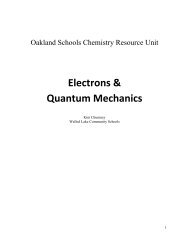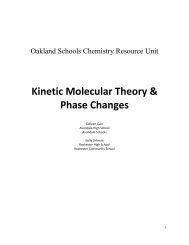Nomenclature and Chemical Reactions - Oakland Schools
Nomenclature and Chemical Reactions - Oakland Schools
Nomenclature and Chemical Reactions - Oakland Schools
You also want an ePaper? Increase the reach of your titles
YUMPU automatically turns print PDFs into web optimized ePapers that Google loves.
Content Statements:<br />
C4.2 <strong>Nomenclature</strong><br />
<strong>Nomenclature</strong> <strong>and</strong> <strong>Chemical</strong> <strong>Reactions</strong><br />
All compounds have unique names that are determined systematically<br />
C4.2x <strong>Nomenclature</strong><br />
All molecular <strong>and</strong> ionic compounds have unique names that are determined<br />
systematically.<br />
C3.4 Endothermic <strong>and</strong> Exothermic <strong>Reactions</strong><br />
<strong>Chemical</strong> interactions either release energy to the environment (exothermic) or absorb<br />
energy from the environment (endothermic).<br />
C5.2 <strong>Chemical</strong> Changes<br />
<strong>Chemical</strong> changes can occur when two substances, elements, or compounds interact<br />
<strong>and</strong> produce one or more different substances whose physical <strong>and</strong> chemical properties<br />
are different from the interacting substances. When substances undergo chemical<br />
change, the number of atoms in the reactants is the same as the number of atoms in<br />
the products. This can be shown through simple balancing of chemical equations. Mass<br />
is conserved when substances undergo chemical change. The total mass of the<br />
interacting substances (reactants) is the same as the total mass of the substances<br />
produced (products).<br />
C5.5 <strong>Chemical</strong> Bonds-Trends<br />
An atom’s electron configuration, particularly of the outermost electrons, determines<br />
how the atom can interact with other atoms. The interactions between atoms that hold<br />
them together in molecules or between oppositely charged ions are called chemical<br />
bonds.<br />
C5.6x Reduction/Oxidation <strong>Reactions</strong><br />
<strong>Chemical</strong> reactions are classified according to the fundamental molecular or sub<br />
molecular changes that occur. <strong>Reactions</strong> that involve electron transfer are known as<br />
oxidation/reduction (or “redox”).<br />
2
















